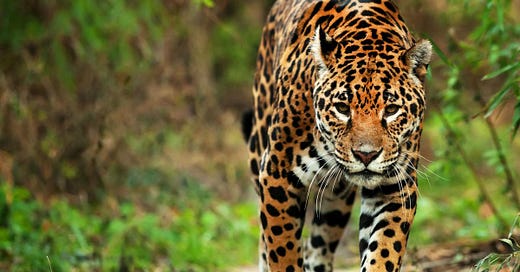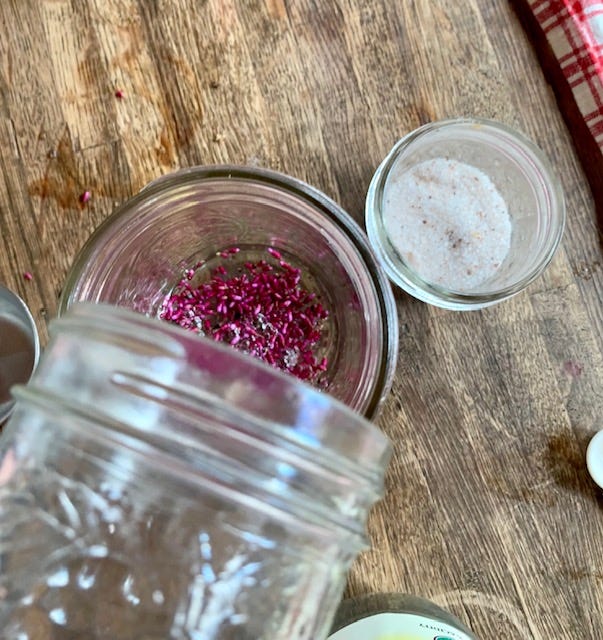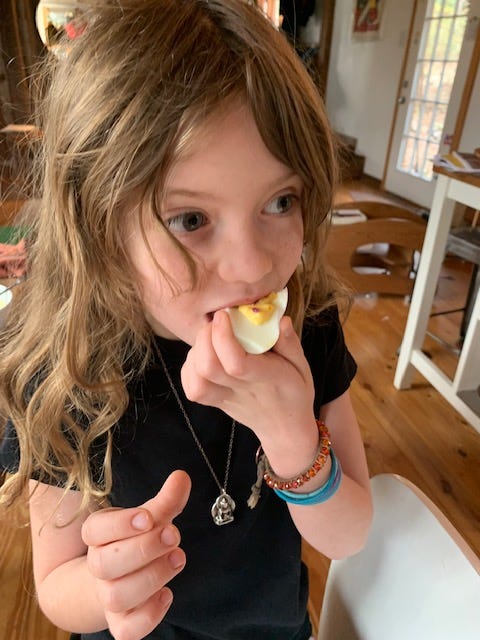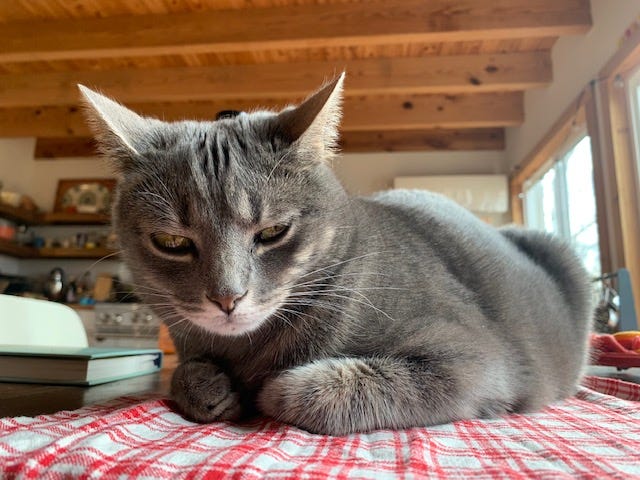Welcome back to big cat month!
The third biggest cat in the world, and the largest cat to live in the Americas, is the beautiful and fearsome jaguar. The jaguar is the strongest of the big cats, able to take down animals as large as bulls. Jaguars can be six feet long and more than 200 pounds, and they are very muscular, with the most powerful jaws in the cat family. They used to be even larger and stronger, preying on megafauna like the giant, prehistoric capybaras—until humans hunted the megafauna into extinction.
As ruler of the Underworld, the jaguar is also an important part of Mayan mythology, representing ferocity and valor. Because of their superior ability to see at night, jaguars were also thought capable of moving between worlds.
Today jaguars live in 18 countries in Latin America, from Mexico to Argentina (and even a few in Arizona and New Mexico!). The largest number of jaguars can be found in Brazil, where almost half of the world’s jaguars live in rainforests and wetlands. Jaguars often live near water because they are great swimmers and like sneaking up on caimans, which look like chunky little alligators. Like lions and tigers, jaguars are keystone predators, helping to keep the population of other species in balance.
According to the World Wildlife Fund, the name jaguar comes from the indigenous word “yaguar,” meaning “he who kills with one leap.” Jaguars are stealthy hunters whose spotty coats help to camouflage them as they sneak up on prey, including capybaras, deer, wild pigs, caimans, and monkeys. Their jaws are so strong they can crunch through tortoise shells! (Pssst: Harriet thought the jaguar we were reading about was an African cheetah. But here’s how to tell the difference at a glance: jaguars are stocky and muscular! And unlike cheetahs and leopards, jaguars have a black dot inside the rosettes, or circular patterns, of their coats.)
A group of jaguars is called a prowl or a leap—but unlike the social, matriarchal lions, you won’t usually find them in a group. Jaguars are solitary, except during mating season. Kittens live with their moms for about two years.
Jaguars aren’t as endangered as lions and tigers—they are considered “near threatened,” meaning their population is decreasing. Why is that? Basically, the same reasons other big cat numbers are in decline: habitat loss, loss of wild prey, illegal hunting and poaching, and killing by farmers defending livestock. Jaguars have been eradicated from 40% of their historic range.
This Animalogic video is a great introduction to the jaguar and her challenges:
We were especially interested in the problem of habitat fragmentation that the video touches on—this is what happens when big forests and wetlands are broken up into smaller chunks of forest and wild places. For jaguars, this means that their migration routes are disrupted, and the resulting isolated populations aren’t as genetically diverse as they should be, making it easier for them to get sick or have other problems. The U.S.-Mexico border wall, constructed by the U.S., is a physical barrier that also interferes with jaguar migration.
One of the biggest ways you can help jaguars is to stop eating meat, especially beef. Cattle ranching is responsible for 80 percent of the deforestation of the Amazon rainforest.
You can learn more about efforts to restore the jaguar corridor here. And more about arguments for restoring jaguars to the U.S. here.
Ever Green: Saving Big Forests to Save the Planet is an important new book by John W. Reid and the late Thomas E. Lovejoy (it comes out on March 29) that explains why preserving the world’s largest forests is essential to our survival, and what preserving actually means—no roads, no construction, no development in these big forests. I’m reading it now, and sharing the more captivating short sections with Bea. Apparently she likes the book:
Have you read any great books lately? We always love your recommendations!
In our own forest, we’ve started some spring foraging. Here’s a recipe Bea is excited to share:
Spring Redbud Capers (adapted from Victuals by Ronni Lundy, who adapted this recipe from her friend Lora Smith):
1. Find a redbud tree that is just about to bloom. Pick a handful of unopened blossoms or buds. Don’t pick too many from one tree!
2. Wash the buds in a bowl of water. Drain in a fine-mesh colander and pick the stems off of the buds.
3. Mix 2 tablespoons of distilled white vinegar with two tablespoons of water and a half teaspoon of kosher salt. Stir until the salt dissolves. Pour this over the buds in a sterilized jar.
4. Seal the jar with a sterilized lid (you don’t need to do this in a boiling water bath, just cover the jar), and set it in a cool, dark place for three days. Make sure the buds are in the brine solution instead of on the sides of the jar.
5. After three days, your capers are ready—salty, tangy, and beautiful! We added ours, along with a tablespoon of redbud brine, to a simple recipe from Victuals for deviled eggs. Delicious!
Hope you frog troublers have a great weekend! What are your plans? We’re hoping to watch beaver activity tonight on the banks of the Haw… and we’ll be back on Sunday with a conversation and some thoughts about banned books.











I thought you were going to say Harriet thought you were talking about a car. I found the difference in the coats fascinating. I am going to google and compare cheetahs, leopards , and jaguars right after I post this. We have not eaten beef since January 1, 2022, and we have kept to our pledge because of FTT. We only eat meat 2 days a week now and only seafood or chicken. I know we need to cut out chicken, too, but fried chicken( although I seldom indulge) would be my preference for my last supper, and I know how to prepare chicken a bazillion ways. I feel like a monster admitting that I eat it. Look away! My love to all, and I hope you find beavers at work.
I really enjoy your newsletter! And I love VICTUALS – we met Ronni at a wedding and I'm so glad we took her book home! I wonder if you take prompts/questions for nature investigations? I want to know why there are so many squirrels this year (we are in Texas). I've had to cover my raised beds in netting for the first time and still they manage to mess up my seedlings. Thank you!